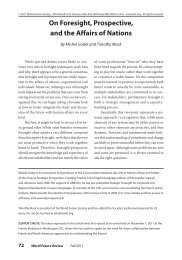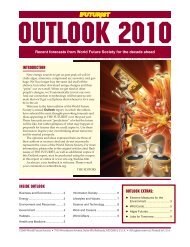Trends Shaping Tomorrow's - World Future Society
Trends Shaping Tomorrow's - World Future Society
Trends Shaping Tomorrow's - World Future Society
You also want an ePaper? Increase the reach of your titles
YUMPU automatically turns print PDFs into web optimized ePapers that Google loves.
to nothing. Increased surveillance<br />
has become socially acceptable in an<br />
age when many people fear terrorism<br />
and crime. In the United States,<br />
the growth of surveillance also is<br />
driven by the fear that lawsuits following<br />
a future terrorist attack could<br />
claim that failure to install monitoring<br />
equipment constitutes negligence.<br />
Assessment and Implications: In<br />
the future, privacy is likely to be defined,<br />
not by the ability to keep information<br />
truly secret, but by the legal<br />
power to restrict its distribution.<br />
Even this limited form of privacy<br />
will be eroded as both government<br />
and private organizations find legal<br />
justification for their interest in personal<br />
information. Once access is<br />
granted to any type of information, it<br />
is unlikely ever to be rescinded.<br />
In large and medium-sized cities<br />
around the world, spaces that remain<br />
unwatched by video cameras will<br />
continue to shrink.<br />
Growing numbers of companies,<br />
and even private citizens, will encrypt<br />
their computer data.<br />
The number of criminal cases<br />
based on surveillance will grow rapidly<br />
in countries with the required<br />
technological sophistication and infrastructure.<br />
Private citizens increasingly will<br />
use similar technologies to watch<br />
over government abuse, as in cases<br />
where bystanders have recorded police<br />
misconduct with their cell-phone<br />
cameras.<br />
■<br />
The physical-culture and<br />
personal-health movements<br />
will remain strong, but far from universal.<br />
• Emphasis on preventive medicine<br />
continues to grow. Of late, a few<br />
insurance carriers—but more each<br />
year—have expanded coverage or<br />
reduced premiums for policyholders<br />
with healthy lifestyles.<br />
• Legislation has sometimes mandated<br />
change. Since 2005, for instance,<br />
49 out of 50 U.S. states have<br />
required insurers to pay for mammograms.<br />
• Health is continuing to improve<br />
in the United States, but less quickly.<br />
During the 1990s, health in the<br />
United States improved by 1.5% annually,<br />
based on such measures as<br />
• In the United States, workers<br />
spend about 10% more time on the<br />
job than they did a decade ago. European<br />
executives and nonunionized<br />
workers face the same trend.<br />
• Computers, electronic communications,<br />
the Internet, and other technologies<br />
are making national and international<br />
economies much more<br />
competitive.<br />
• In this high-pressure environment,<br />
single workers and twoincome<br />
couples are increasingly desperate<br />
for any product that offers to<br />
simplify their lives or grant them a<br />
taste of luxury—and they can afford<br />
to buy it.<br />
• China’s rapid economic development<br />
means its workers also are<br />
experiencing faster-paced and timepressured<br />
lives. In a recent survey by<br />
the Chinese news portal Sina.com,<br />
56% of respondents said they felt<br />
short of time.<br />
• Technical workers and execusmoking<br />
prevalence, health-insurance<br />
coverage, infant mortality rates,<br />
and premature deaths. During the<br />
2000s, health improvement has<br />
slowed to just 0.2% a year.<br />
• Health consciousness is spreading<br />
to Europe. For example, a recent<br />
poll found that two-thirds of Britons<br />
now spend more to maintain a<br />
healthy lifestyle than they did a decade<br />
ago, and three out of four say<br />
they enjoy leading a healthy lifestyle.<br />
Unfortunately, much of the developing<br />
world still worries more about<br />
eating enough than about eating<br />
healthy.<br />
• Smoking is in general decline in<br />
the United States. Fewer than 20% of<br />
American adults smoked cigarettes<br />
as of 2007, down from 24.7% in 1997,<br />
according to the Centers for Disease<br />
Control. This is still far from the<br />
CDC’s Healthy People 2010 Goal of<br />
12%. About 42.5% of current smokers<br />
reported that they had tried to<br />
stop smoking within the last year.<br />
• The antismoking movement also<br />
has made its way to Europe. Ireland<br />
banned smoking from its pubs late<br />
in April 2004. In 2006, France banned<br />
smoking in public facilities. Britain<br />
followed suit in 2007.<br />
• The global obesity crisis is a significant<br />
countertrend to the physicalculture<br />
movement. Poor diet, physical<br />
inactivity, and associated obesity<br />
contribute to 47% of diseases and<br />
60% of deaths worldwide. Developing<br />
countries that “Westernize” their<br />
diets by consuming more foods high<br />
in fat, sugar, and salt are at risk of<br />
epidemic obesity, including among<br />
children and adolescents.<br />
• The current epidemic of obesity<br />
in the United States is especially<br />
troubling. The number of children<br />
who are overweight has tripled since<br />
1980, to about 18% for those age six<br />
or older. However, there is some evidence<br />
that obesity has begun to stabilize<br />
among American adults. The<br />
rate of obesity among women appears<br />
to have reached a plateau in<br />
the last six years.<br />
Assessment and Implications:<br />
Continuing health improvements in<br />
the industrialized world will be accompanied<br />
by a dramatic rise in<br />
heart disease, diabetes, cancer, and<br />
other such “lifestyle” disorders in<br />
the developing lands.<br />
As the nutrition and wellness<br />
movements spread, they will further<br />
improve the health of the elderly.<br />
Better health in later life will make<br />
us still more conscious of our appearance<br />
and physical condition.<br />
Thus, health clubs will continue to<br />
boom, and some will specialize in<br />
the needs of older fitness buffs. Diet,<br />
fitness, stress control, and wellness<br />
programs will prosper.<br />
By 2015, Congress will add coverage<br />
of many preventive-care activities<br />
to Medicare benefits.<br />
The cost of health care for American<br />
baby boomers and their children<br />
could be much lower in later life<br />
than is now believed. However, Asia<br />
faces an epidemic of cancer, heart<br />
disease, emphysema, and other<br />
chronic and fatal illnesses related to<br />
health habits.<br />
Like tobacco companies, producers<br />
of snack foods, liquor, and other unhealthy<br />
products will increasingly<br />
target markets in developing countries<br />
where this trend has yet to be<br />
felt.<br />
Chronic diseases related to obesity<br />
burden national economies and<br />
could thwart economic progress in<br />
developing countries.<br />
■<br />
Time is becoming the world’s<br />
most precious commodity.<br />
THE FUTURIST May-June 2010 43
















